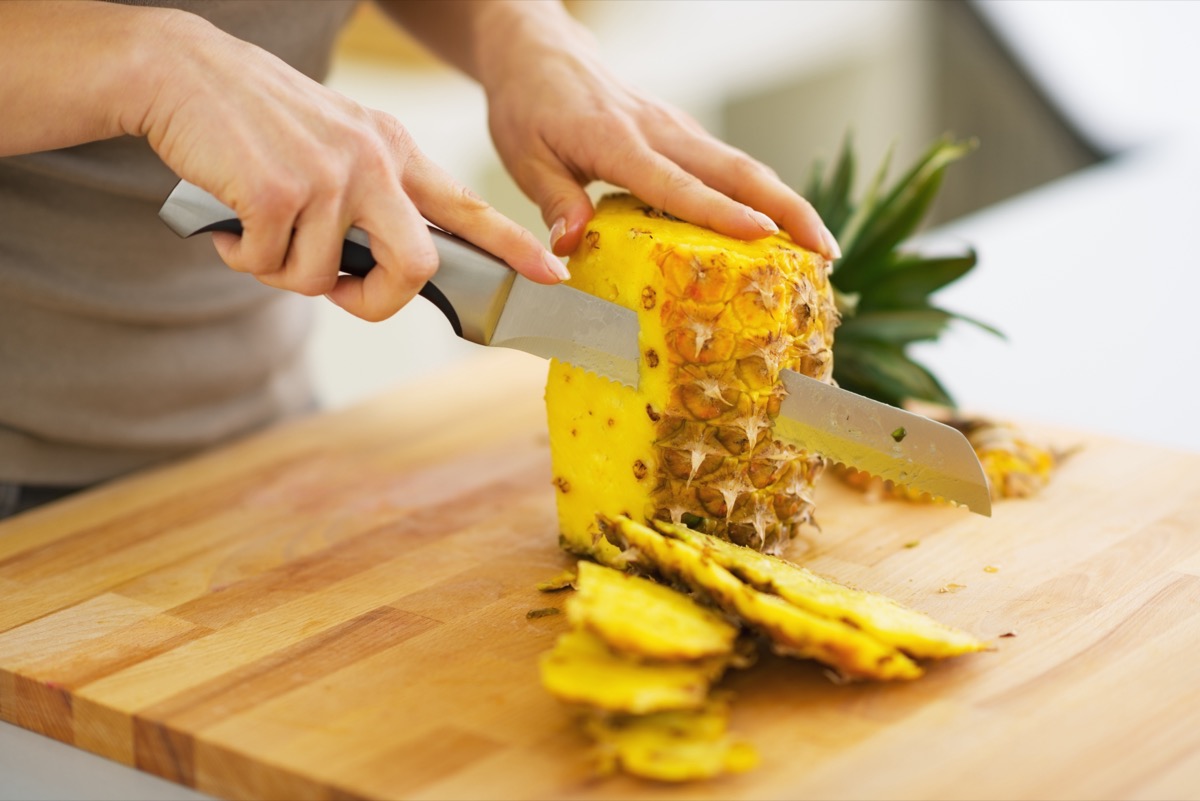
HOW TO CUT A PINEAPPLE PERFECTLY EVERY TIME
Craving a tasty summer snack? While you can certainly pick up precut versions of pineapple from your local grocery store, that's a pricier option with a shorter shelf life. With that in mind, you might prefer to buy a full pineapple. Once you get it home, however, you may not know where to start when cutting the intimidating fruit—or perhaps your method isn't proving all that effective. Wondering how to attack this beloved tropical food? We've got you covered with instructions on how to cut a pineapple perfectly every time.
RELATED: How to Safely Store Fruit to Keep It Fresh and Tasty.
How to Cut a Pineapple
1. Remove the crown and base.
Michelle Routhenstein, MS, RD, CDE, CDN, preventive cardiology dietitian at Entirely Nourished, says you should start by removing the crown and the pineapple base. To do so, place the pineapple on its side and use a sharp knife to slice off the top (the part with the spikes) and the bottom.
2. Peel the pineapple.
From there, stand the pineapple up and use your knife to remove the skin from the fruit's flesh from top to bottom. It will take several cuts to do this, so rotate the pineapple for each new cut.
3. Slice it in half or cut into rings.
Next, cut the pineapple in half lengthwise to create two equal halves. (If you prefer rings, place the peeled pineapple on its side and slice into desired widths.)
4. Cut it into fourths.
Then, place the halves facedown to lay flat on your cutting board and cut each in half again.
5. Remove the core from each quarter or ring.
You should also remove the tough core, which isn't typically eaten. It can be identified by its lighter color in the center.
Stand each quarter of your pineapple and remove the lighter yellow portion with your knife. (For rings, use a circular cookie cutter to remove the core from each slice.)
6. Slice into desired size and enjoy.
Once the core is removed, you can cut each fourth of pineapple into chunks, sticks, or slices.
RELATED: 2024's "Dirty Dozen": 12 Fruits and Vegetables With the Most Pesticides.
How to Tell If Pineapple Is Ripe
Due to its tough and thick skin, determining whether a pineapple is ripe and ready to eat may seem tricky. In reality, however, all you have to do is look for a few key signs, according to ThePioneerWoman.com
If your pineapple is ready, it will feel heavy in your hand and slightly soft. It will also have a syrupy, sweet smell to it. A lack of smell means the pineapple probably isn't ripe just yet, while a "funky" smell means it might be past its prime.
The color is also a giveaway. Ripe pineapples are more yellow, while dark green pineapples are underripe and deep yellow and orange pineapples are likely overripe, ThePioneerWoman.com concludes.
RELATED: The 10 Best Meal Prep Containers, Nutritionists Say.
How to Store Pineapple
Before you've cut your pineapple, you don't need to worry too much about storage. According to Routhenstein, whole pineapples can be safely stored at room temperature briefly before refrigerating.
After you've cut the pineapple, though, you'll want to put the cubes or slices in an airtight container and store that in the fridge. If you have larger pieces of pineapple, you can also wrap them tightly in plastic wrap.
"Once cut, it will remain fresh for up to four to five days if properly stored," Routhenstein says. "By storing pineapple properly in this way, it ensures the pineapple retains its flavor and nutritional benefits throughout its storage period."
If you're bringing your pineapple along to a barbecue or cookout, Rhyan Geiger, RDN, plant-based dietitian at Phoenix Vegan Dietitian, cautions against leaving it out for too long in the summer sun.
"If the outside temperature is over 90 degrees Fahrenheit, dangerous bacterial growth can start in just one hour!" she warns.
RELATED: 7 Best Food Processors Chefs Have in Their Own Kitchens.
Best Things to Serve With Fresh Pineapple
Pineapple is certainly delicious on its own, but it also pairs well with several different sweet and savory foods.
Of course, it's a welcome addition to a fruit salad and tastes great when combined with cottage cheese. Depending on who you ask, it also makes for a perfect pizza topping. However, your options don't stop there—and you can also maximize the health benefits.
"Pineapple pairs well with heart-healthy fats like avocado or an almond butter drizzle because pineapples derive their vibrant yellow color from carotenes and xanthophylls, which are fat-soluble antioxidants requiring fat for optimal absorption," Routhenstein shares.
Geiger also recommends grilling pineapple and putting it on skewers with a protein source and veggies. While delicious, Routhenstein does note that heat can affect pineapple's bromelain, which is "an enzyme known for its digestive benefits and anti-inflammatory properties."
Conclusion
If you're a pineapple-lover, consider these tips to ensure that you not only pick up the perfect pineapple from the grocery store, but also get the most out of your fruit! Regardless of where you stand on the pineapple on pizza debate, rest assured that there are endless ways to enjoy it during the summer or at any time of the year.
Best Life is your source for the best home cooking and food safety advice. Check back for more content to help with prep and storage tips!
RELATED: For more up-to-date information, sign up for our daily newsletter.
Read the original article on Best Life.
2024-07-01T12:25:41Z dg43tfdfdgfd